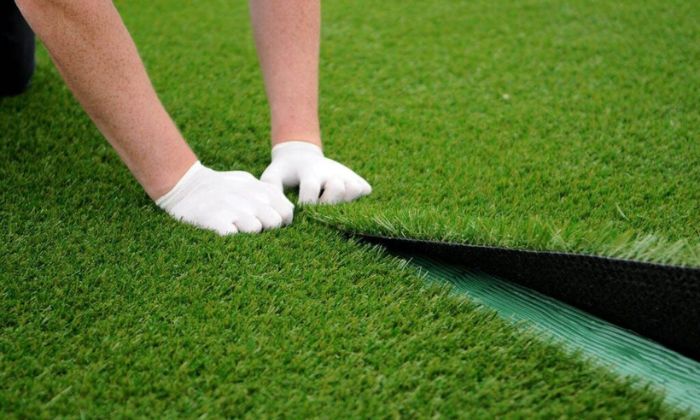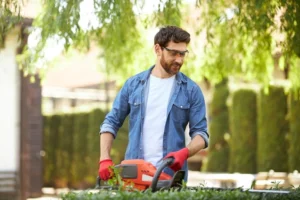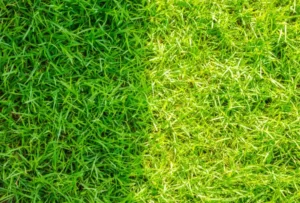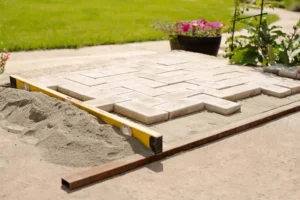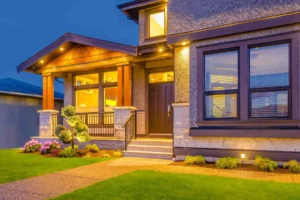Artificial grass installation has become an increasingly popular choice for homeowners, businesses, and sports facilities seeking a low-maintenance, sustainable, and aesthetically pleasing lawn. Whether you are considering synthetic grass for your backyard, commercial property, or sports field, the benefits are hard to ignore. This article will discuss the advantages of artificial grass, the steps involved in its installation, and tips to ensure you get the best value for your investment. We will also touch on the cost of artificial grass installation and how Lakota Design Group can help you achieve a beautiful, low-maintenance lawn.
Benefits of Artificial Grass
Low Maintenance
Artificial grass offers low maintenance, making it a popular choice for homeowners. With Bay Area landscaping expertise, professional landscape installation ensures that artificial turf is perfectly laid out, providing a virtually maintenance-free solution. Unlike natural grass, which requires regular watering, mowing, and fertilizing, artificial turf doesn’t need any watering, reducing water bills and conserving resources. It also eliminates the need for mowing, saving time and effort. Additionally, artificial grass remains lush and green throughout the year, regardless of weather conditions. This makes it a convenient, cost-effective, and eco-friendly option for maintaining a beautiful lawn without the hassle of traditional lawn care.
Durability and Long Lifespan
Artificial grass is highly durable and can endure harsh weather conditions, making it a long-lasting alternative to natural grass. With proper maintenance, synthetic turf can last 15 to 20 years, depending on factors like turf quality and installation. Its ability to withstand heavy foot traffic, UV exposure, and varying weather ensures a consistently well-maintained lawn with minimal wear and tear. This longevity makes artificial grass a cost-effective, low-maintenance choice for homeowners looking for a durable and attractive lawn solution over the long term.
Eco-Friendly
Artificial grass is an eco-friendly choice because it conserves water, particularly in drought-prone regions, by eliminating the need for frequent watering. This significantly reduces water usage. Moreover, artificial turf eliminates the need for pesticides and fertilizers, which are often harmful to the environment. By choosing artificial grass, you contribute to a reduction in chemical runoff and the preservation of natural resources, making it a sustainable alternative to traditional grass lawns. The reduced maintenance and lower environmental impact make it an ideal choice for those looking to minimize their ecological footprint.
Aesthetic Appeal
Artificial grass offers a consistently vibrant, green lawn that enhances the aesthetic appeal of any outdoor space. Unlike natural grass, which can suffer from patches or browning during dry periods, artificial turf remains lush and even throughout the year. This low-maintenance solution ensures a pristine appearance in all weather conditions, making it perfect for homeowners and businesses seeking an attractive, hassle-free landscape. With artificial grass, you can enjoy a beautiful, green lawn year-round without the constant upkeep required by traditional grass, making it a convenient and visually appealing option for outdoor areas.
Pet and Child-Friendly
Synthetic grass is an excellent choice for families with pets and children. It provides a soft, safe surface for play, minimizing the risk of injury. Unlike natural grass, artificial turf is durable and can withstand the wear and tear caused by pets running around or kids playing games. Additionally, it doesn’t attract pests like fleas, ticks, or mosquitoes, offering a cleaner and healthier environment. This low-maintenance option ensures that both pets and children can enjoy outdoor activities without the concerns associated with traditional lawns.
How to Install Artificial Turf Grass on Dirt or Soil
The process of installing artificial grass involves several key steps to ensure a durable and high-quality result. Whether you are handling the installation yourself or hiring a professional, understanding the process will help you make informed decisions.
Step 1: Clear the Area
Clear the Area involves preparing the ground for artificial grass installation. Begin by removing any existing grass, weeds, or debris that may hinder the process. This step is crucial to create a clean, stable surface for the turf. Ensure all organic materials are cleared to prevent uneven installation. Additionally, laying down a weed barrier helps block weeds from growing through the synthetic grass later on, ensuring long-term maintenance and a tidy, durable surface for your artificial lawn. This foundational step is key for a successful and lasting installation.
Step 2: Prepare the Subbase
Step 2 involves preparing the subbase by compacting the ground to ensure proper drainage and stability. This prevents the artificial turf from shifting over time. A stable foundation is created using base materials like crushed rock or gravel. The compacted base helps water flow efficiently, avoiding pooling or uneven surfaces. Additionally, a weed barrier is laid at this stage to prevent unwanted plant growth beneath the turf, ensuring the longevity and neat appearance of the artificial lawn. This step is crucial for creating a solid foundation that supports the turf’s performance and durability.
Step 3: Laying the Artificial Grass
Laying the Artificial Grass involves rolling out the turf over the prepared subbase. Carefully cut the grass to match the dimensions of the space, ensuring a precise fit. It’s essential to align the grass blades in the same direction to achieve a natural appearance. If the area is large, you may need to join multiple sections of turf. Be sure to trim the edges neatly for a seamless look. This step is crucial for creating a realistic and well-fitted artificial lawn that blends seamlessly into the surroundings.
Step 4: Securing the Grass
Securing the Grass involves ensuring the artificial turf stays in place. The seams of the grass should be joined carefully using either adhesive or nails, based on the type of turf. Proper fastening is crucial to prevent the grass from shifting or moving over time. Securing the turf effectively helps maintain its appearance and longevity, ensuring it stays in place even with heavy use or weather conditions. This step is essential to prevent the grass from bunching, lifting, or becoming uneven, which could affect both the look and functionality of the artificial lawn.
Step 5: Infill and Finishing Touches
Infill and Finishing Touches involve adding a layer of infill, usually made from sand or rubber to the artificial grass. This helps weigh the turf down and enhances its texture. After spreading the infill evenly, use a brush to lift the grass blades, ensuring they stand upright and look natural. Brushing also prevents matting and maintains the turf’s appearance. This step is crucial for achieving a realistic, durable, and well-maintained artificial lawn. Proper infill application and brushing contribute to both the aesthetic and functional performance of the turf.
Popular Uses for Artificial Turf Grass
Artificial grass installation is versatile and can be used in a variety of settings. Here are some of the most popular applications:
Outdoor Play Areas for Kids
Outdoor play areas for kids benefit greatly from synthetic grass, offering a safe, clean, and comfortable environment. The soft texture of synthetic turf helps minimize the risk of injuries during play, providing a cushion-like effect when children fall or tumble. Additionally, synthetic grass is resistant to pests like insects and bugs, reducing the chances of bites or stings. This makes it an ideal surface for play areas, as it ensures children can enjoy outdoor activities without the concerns associated with natural grass, such as uneven surfaces, mud, or pests. It’s a durable, low-maintenance, and child-friendly choice.
Artificial Turf Grass for Pets
Artificial turf grass is an excellent choice for pet owners due to its durability and ease of maintenance. Unlike natural grass, which can become muddy, patchy, or worn out from pets’ activities, artificial turf stays intact. Pet waste is easily cleaned, and the surface does not get damaged from pets running, digging, or playing. It provides a clean, safe, and low-maintenance outdoor space for pets to enjoy, making it a practical and long-lasting alternative to traditional grass lawns. Additionally, it eliminates the need for constant reseeding or lawn care, saving time and effort.
Backyard Putting Greens
Backyard putting greens are a great way for avid golfers to practice their game at home. Using artificial turf to create a putting green provides a smooth, consistent surface that mimics the feel of a professional course. The durability and low maintenance of artificial grass make it a convenient and cost-effective option for golfers who want to improve their putting skills. Whether for casual practice or serious training, a backyard putting green allows you to enjoy golf in the comfort of your own home, anytime you want, without worrying about upkeep or weather conditions.
Sports Fields
Artificial turf is widely used in sports fields for its durability and ability to endure heavy use. Unlike natural grass, synthetic turf can withstand the intense wear and tear of high-impact sports like football, soccer, and baseball. It offers consistent performance with minimal maintenance requirements, making it ideal for fields that experience frequent play. The turf remains lush and visually appealing, even after extensive use, ensuring that sports fields maintain a professional appearance throughout the season. Its durability and ease of care make artificial grass a popular choice for both professional and recreational sports facilities.
Commercial Landscaping
Commercial landscaping often involves the use of artificial grass due to its low maintenance and cost-effective benefits. Unlike natural grass, artificial turf requires no mowing, watering, or fertilizing, reducing long-term maintenance costs for businesses. It offers a consistently neat, green appearance year-round, contributing to a professional and aesthetically pleasing environment. This makes it an ideal choice for commercial properties, such as office buildings, hotels, and retail centers, where appearance is important, but maintaining natural grass can be time-consuming and expensive. Artificial grass is both environmentally friendly and practical for businesses looking to reduce upkeep. Additionally, when incorporated into landscape design, it can enhance the overall look of a property, creating a clean, modern, and well-maintained exterior.
Tips for a Successful Installation
Proper installation is crucial to the longevity and performance of artificial grass. Here are some tips for ensuring a successful installation:
Proper Alignment and Seam Joining: Take the time to align the turf correctly and ensure the seams are joined tightly to avoid visible gaps or wrinkles.
Ensure Proper Drainage: Proper drainage is essential to prevent water from pooling on the surface. Be sure that the subbase is sloped to allow for effective drainage.
Correct Infill Application: Use the right amount of infill to prevent matting and ensure the grass blades remain upright. Too little infill can lead to uneven grass, while too much can cause the fibers to become stiff.
Common Mistakes to Avoid
There are a few common mistakes to watch out for during artificial grass installation:
Choosing Poor-Quality Artificial Grass: Opting for cheaper, low-quality turf can result in a shorter lifespan and less attractive appearance. Invest in high-quality artificial grass for better durability and a more natural look.
Skipping the Sub Base Preparation: Neglecting to prepare the subbase can lead to poor drainage and cause the artificial grass to shift or wear unevenly.
Inadequate Infill or Improper Installation Techniques: Incorrect installation or insufficient infill can result in a poor finish and reduced durability.
Neglecting Drainage Solutions: Without proper drainage, water can collect under the artificial grass, leading to issues like mold or mildew growth.
Maintenance of Artificial Grass
While artificial grass is low-maintenance, it still requires some care to keep it looking its best:
Regular Cleaning: Remove debris, leaves, and pet waste regularly to prevent buildup. Use a leaf blower or broom to clean the surface.
Brushing the Fibers: Periodically brush the fibers to maintain their appearance and prevent matting.
Replacing Infill: Over time, the infill can become compacted or wash away. Replenish the infill as necessary to maintain the texture and weight of the grass.
Cost of Artificial Grass Installation
The cost of artificial grass installation depends on several factors, including the size of the area, the quality of the turf, and whether you hire a professional installer. While the initial installation cost may be higher than natural grass, the long-term savings on water bills, lawn care, and maintenance make it a cost-effective option. Be sure to get a detailed estimate that includes labor costs, materials, and any additional services.
Finding Affordable Artificial Grass Installation Services
At Lakota Design Group, we specialize in providing affordable artificial grass installation services for both residential and commercial properties. We offer high-quality synthetic turf and professional installation services to ensure your lawn looks perfect and performs well for years to come. Contact us today for a consultation, and let us help you create the lawn of your dreams.
Conclusion
Artificial grass installation is an excellent choice for anyone seeking a low-maintenance, eco-friendly, and durable lawn. Whether you’re installing it for your home, business, or sports field, the benefits are undeniable. With the right installation process and maintenance, your artificial turf can provide years of enjoyment without the hassle of traditional grass care. If you’re looking for affordable artificial grass installation, Lakota Design Group is here to help you transform your outdoor space.

